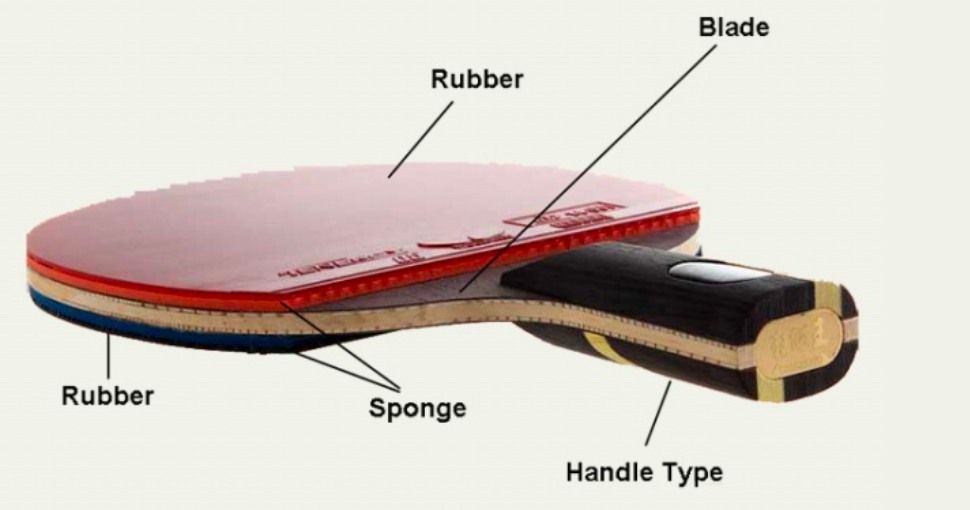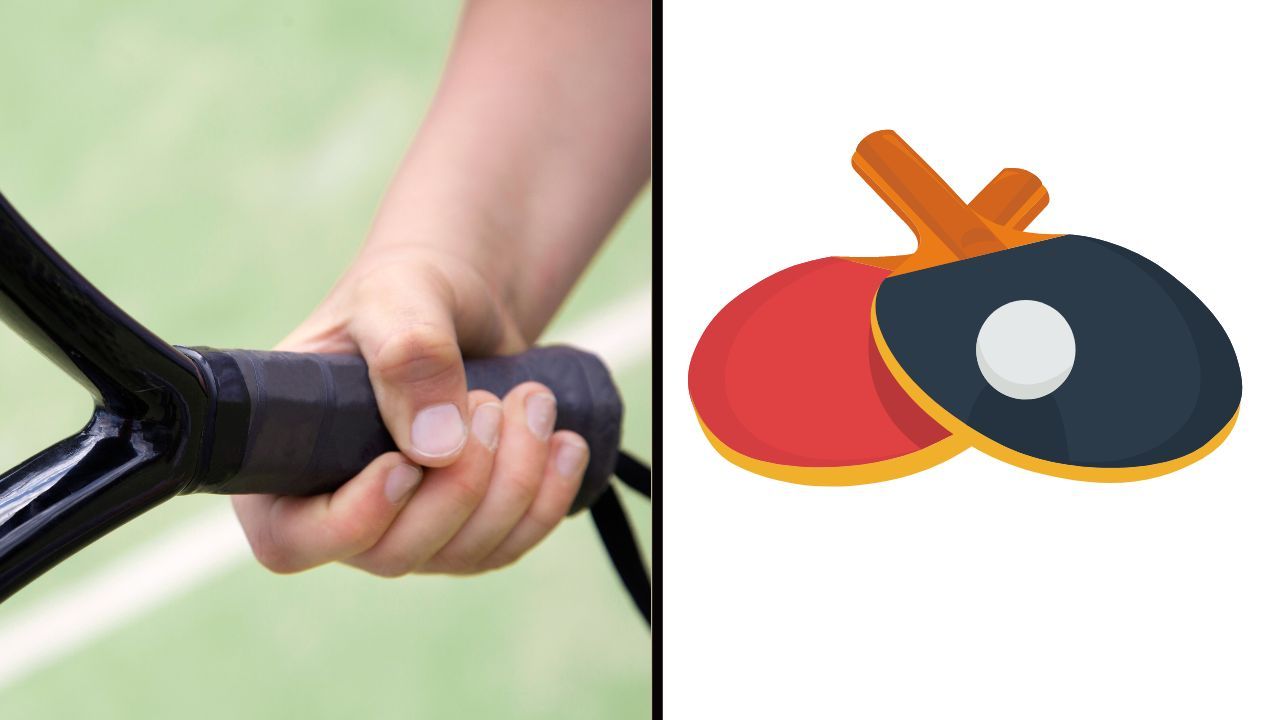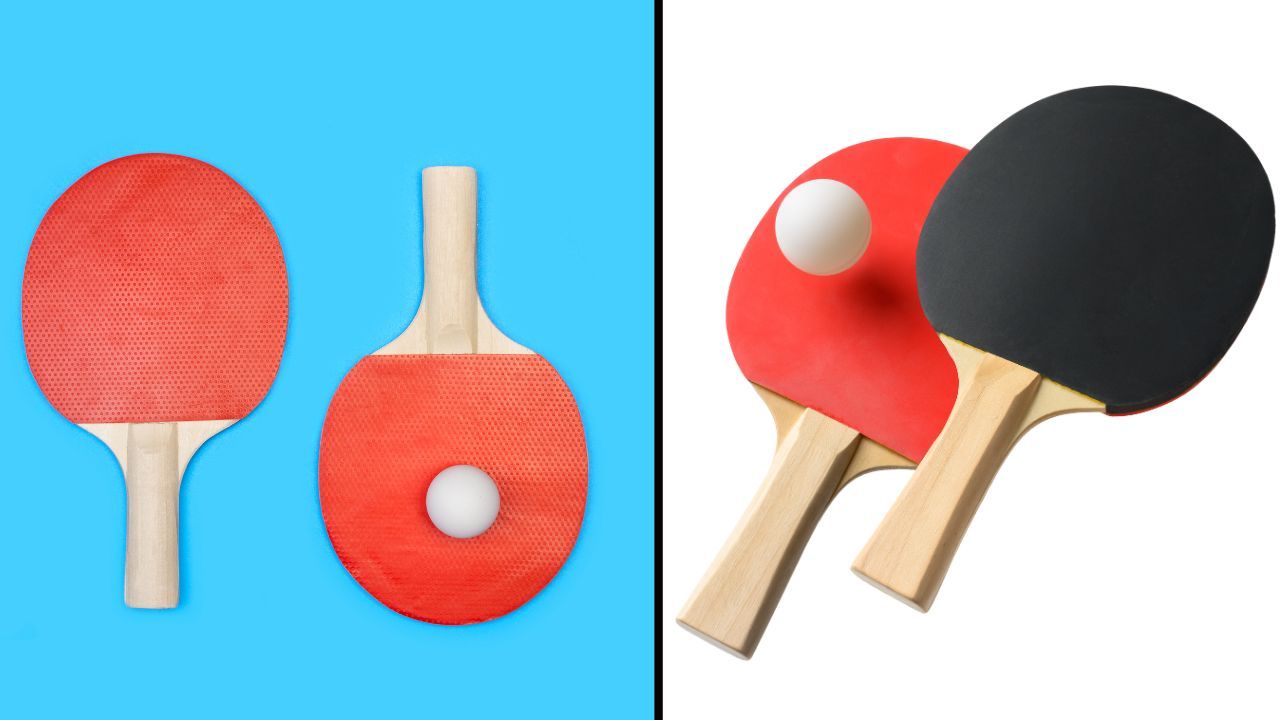What Ping Pong Paddle Should I Get?
Discovering the ideal ping-pong paddle is like finding a secret weapon for your game. Explore the factors that matter most and make an informed choice to unlock your table tennis potential.

What ping pong paddle should you get? Ah, the age-old question that has sparked debates more intense than the greatest ping-pong rivalries. It's like choosing a wand at Ollivanders, but instead of summoning magic, you're summoning furious rallies and awe-inspiring spin shots.
The right paddle can be a game-changer. In this article, we'll unravel the mysteries of ping pong paddles, explore the different types, and help you navigate the thrilling journey of selecting the perfect one that'll make you the undisputed king or queen of the ping pong table. Trust us, it's a paddle-y good time ahead!
The most important aspect of a paddle is its power. The power is measured in the number of pounds of force that the paddle can generate per inch of contact between the ball and the paddle. Some important factors that affect the power of a paddle are the materials used in the grip, blade, and rubber.

Grip
The grip on a ping pong paddle is a critical aspect of your game, influencing your control, comfort, and overall performance. The grip determines how well you can control the ball. A proper grip allows for precise placement and direction of your shots.
An effective grip enables you to generate power and spin on your shots. It influences the racket angle and the amount of wrist movement you can use. A comfortable grip reduces strain during long matches, helping you maintain consistent strokes and footwork.
A secure grip allows for quick adjustments in your strokes to respond to different ball placements and spins from your opponent. A good grip can absorb and reduce the vibrations from the impact of the ball, enhancing comfort and reducing the risk of injury.

A proper grip gives you confidence in your strokes, helping you stay focused and perform at your best under pressure. A secure grip prevents the racket from slipping out of your hand, ensuring you maintain control during intense rallies.
A relaxed but firm grip prevents excessive tension in your forearm, allowing for smoother, more fluid strokes. Consistency in your grip helps maintain consistent shot quality and placement, which is essential for winning points.
Blade
The blade, or racket, is a crucial component of a ping pong paddle, and its importance in your game cannot be overstated. Here's why the blade is important:
The blade's composition and quality greatly influence your ability to control the ball and feel its contact with the paddle. The blade plays a significant role in determining the speed and power of your shots. Different blade types offer varying levels of speed.
Blade design affects your ability to generate spin. Some blades are better suited for creating topspin, backspin, or sidespin. Different blades allow for diverse shot types, enabling you to adapt your game to various opponents and situations.
Blades can be customized by combining them with different rubber types, allowing you to tailor your paddle to your playing style. The blade's quality impacts its durability. A well-constructed blade is less likely to break or wear out quickly.

Blade weight and balance influence your comfort and maneuverability on the table. Finding the right balance is crucial for your playing style. Quality blades strike a balance between speed and control, allowing you to maintain accuracy even on powerful shots.
Rubber
The rubber on a ping pong paddle is a critical component that directly impacts your playing style and performance. Rubber provides a grip on the ball, allowing you to generate and control spin effectively. Different rubber types offer varying levels of spin potential.
Rubber influences your ability to control the ball, determine its trajectory, and place it accurately on the table. The thickness and composition of the rubber affect the speed and power of your shots. You can choose rubber to match your preferred playing style, whether it's offensive or defensive.
The rubber allows for a wide range of shot variations, from powerful drives to delicate drop shots and deceptive spins. Rubber can be customized by selecting different sponge thicknesses and rubber types, enabling you to tailor your paddle to your playing style.
High-quality rubber maintains its performance over time, ensuring consistent shot quality and reliability. Some rubbers have a tacky surface that enhances the grip on the ball, allowing for more spin and control.
Durable rubber can withstand the wear and tear of intensive play, providing long-lasting performance. Rubber influences your ability to return serves effectively, whether it's absorbing spin or generating your own.
The right rubber can give you a competitive edge, as it complements your playing style and enhances your strengths.
Spin
Spin and control are two crucial elements in table tennis that directly influence your ability to dominate rallies and outmaneuver opponents. Spin allows you to create a wide variety of shots, including topspin, backspin, sidespin, and no-spin, making your game unpredictable.
Spin plays a vital role in both offensive and defensive strategies. Offensive players use spin to add speed and depth to their shots, while defensive players use it to control the ball and disrupt their opponent's rhythm. Spin affects the trajectory of the ball, causing it to dip, curve, or bounce unpredictably, making it challenging for your opponent to read and respond.
Effective use of spin during serves and returns can catch your opponent off guard, leading to weaker responses and easier opportunities to score points. Spin can confuse your opponent, as they may misjudge the spin on the ball, leading to errors or weak returns.
Control
Control allows you to place the ball precisely where you want it on the table, targeting your opponent's weaknesses and creating opportunities for attacking shots. Good control ensures that you can consistently hit the ball where you intend to, reducing unforced errors and mishits.
Control helps maintain shot consistency, allowing you to replicate successful strokes and strategies reliably. Control enables you to adjust your shots quickly in response to your opponent's moves and changing game dynamics.
The ability to control the ball during rallies helps you extend points, forcing your opponent to make mistakes or open up opportunities for attack. Control often takes precedence over power, as precise ball placement can win points even without overwhelming speed.
Speed
Speed and power are critical components of a ping-pong paddle that can give you a competitive edge and elevate your game. Speed allows you to execute fast, offensive shots that catch your opponent off guard, making it challenging for them to react.
Speed aids in delivering shots to various parts of the table quickly, giving you control over the rally and forcing your opponent to cover more ground. Speedy shots can be winners, putting pressure on your opponent and increasing your chances of scoring points.
Speed is essential for counterattacking your opponent's powerful shots, enabling you to return fast-paced balls effectively. Speedy serves and quick third-ball attacks can disrupt your opponent's game plan and set the tone for the point.
Speed can help you dictate the pace of the rally, allowing you to maintain the upper hand.
Power
Powerful shots can overwhelm your opponent, making it difficult for them to control the ball and respond effectively. Power is crucial for finishing shots, such as smashes or powerful drives, that can secure points decisively.
Powerful shots can penetrate your opponent's defense and create openings in their game. Power allows you to play aggressively, taking control of rallies and putting your opponent on the defensive.
A powerful serve followed by a strong attacking shot can set up opportunities for winning points. Power gives you the ability to adapt to different opponents and playing styles, making you a more versatile player.
Weight
The weight and balance of a ping pong paddle significantly impact your playing experience and performance. The weight of the paddle affects how comfortable it is to hold and maneuver during a match.
A slightly heavier paddle can provide better control, as it reduces vibrations and allows for smoother, more stable strokes. Heavier paddles can generate more power in your shots, particularly useful for offensive players who rely on aggressive shots.
A moderate weight provides stability, reducing the chance of mishits and erratic ball placement. Paddles with a suitable weight tend to be more durable and resistant to wear and tear. Different playing styles may benefit from different paddle weights, allowing you to adapt to various opponents and conditions.
Balance
The balance point influences how easily you can maneuver the paddle. A balanced paddle is generally easier to control. The balance can be tailored to favor forehand or backhand play, aligning with your preferred playing style.
The right balance ensures that the paddle feels comfortable and natural in your hand, reducing strain during extended matches. A well-balanced paddle allows for quick reflexes and adjustments during rallies, enhancing your defensive and counterattacking abilities.
Depending on the balance, you can execute a wide range of shots, from powerful drives to precise drop shots. Paddles with adjustable balance points can adapt to different playing conditions and styles.
Where To Find The Perfect Paddle. Check here.
FAQs
What Ping Pong Paddle Should I Get?
Q: Is a light or heavy ping pong paddle better?
Answer: Whether a light or heavy ping pong paddle is better depends on your playing style, preferences, and skill level. Both light and heavy paddles have their advantages, and the choice ultimately comes down to what suits your game best:
Advantages of Light Paddle
- Maneuverability: Light paddles are easier to maneuver, allowing for quick reactions and better control of the ball. They are particularly suitable for players who prioritize precise ball placement and quick adjustments during rallies.
- Defensive Play: Light paddles are often preferred by defensive players who rely on control, placement, and consistency to wear down their opponents.
- Spin Control: Light paddles can be easier to use for generating spin due to their maneuverability. This can be advantageous for players who rely on spin shots.
- Less Fatigue: Light paddles can reduce fatigue during long matches, making them a popular choice for players who engage in extended rallies.
Advantages of Heavy Paddle
- Power: Heavy paddles can generate more power in your shots, making them suitable for aggressive players who rely on fast-paced, powerful attacks.
- Stability: The weight of a heavy paddle can provide stability, reducing vibrations and ensuring that the paddle remains steady during aggressive shots. This can result in fewer mishits.
- Counterattacking: Heavy paddles can be effective for counterattacking your opponent's powerful shots, allowing you to absorb and redirect their energy.
- Smashing: For players who prefer smashing shots, especially in doubles play, a heavier paddle can help deliver powerful smashes.
Q: Does paddle matter in ping pong?
Answer: Yes, the paddle (or racket) matters significantly in ping pong. The paddle is your primary tool for playing the game, and its characteristics can have a profound impact on your performance. Here's why the paddle matters:
- Control: The paddle's composition, weight, and grip influence your ability to control the ball. A well-chosen paddle allows you to place the ball accurately on the table, reducing unforced errors.
- Power: Different paddles offer varying levels of power. Some paddles are designed for powerful offensive play, while others prioritize control and defense. Your paddle choice can affect the speed and force of your shots.
- Spin: Paddle rubber and blade design affect your ability to generate spin on the ball. A paddle that complements your spin style (topspin, backspin, sidespin) can give you an advantage in creating tricky shots.
- Playing Style: Your paddle choice should align with your playing style. Offensive players may prefer paddles that emphasize power and speed, while defensive players may favor paddles that prioritize control and spin.
- Comfort: The grip size and weight of the paddle impact your comfort during play. A well-fitted paddle minimizes discomfort and fatigue during long matches.
- Customization: Paddles can be customized by selecting specific rubbers, blades, and handle types. This allows you to tailor your paddle to your preferences and playing style.
- Competitive Advantage: The right paddle can give you a competitive edge by enhancing your strengths and mitigating weaknesses. It can also help you adapt to different opponents and playing conditions.
- Durability: Paddle quality affects durability. A high-quality paddle can withstand rigorous play and maintain its performance over time.
Q: How do I choose a table tennis paddle for beginners?
Q: What paddle do professional ping pong players use?
Answer: Professional ping pong players use a wide range of paddles, and their choices often depend on their playing style, preferences, and the specific requirements of their game. While there is no single "best" paddle for professionals, some common features and characteristics of paddles used by top-level players include:
- Customization: Professional players often have customized paddles, where they can choose the blade, rubber type, and thickness to suit their playing style.
- High-Quality Blades: The blade (the wooden part of the paddle) is typically of high quality, offering a balance between control and power. Blades may be composed of various types of wood or a combination of wood and carbon fiber.
- Rubber Selection: Professional players often select rubber with a focus on grip, spin, and control. They may choose different rubbers for the forehand and backhand sides to optimize their shots.
- Thickness: The thickness of the rubber sponge can vary. Some players prefer thicker sponges for more power, while others opt for thinner sponges for increased control.
- Balance: The balance of the paddle may be customized to match the player's playing style. Some prefer a more balanced paddle, while others may choose a blade that favors either the forehand or backhand.
- Handle Type: Players can select different handle types, such as straight, flared, or anatomic, depending on their grip preference.
- Brand Preferences: Many professional players have specific brand preferences for blades and rubbers based on their performance characteristics.
- Maintenance: Professional players often take great care of their paddles, cleaning and maintaining the rubber to ensure consistent performance.
Q: Do pros use heavy or light rackets?
Answer: Heavy Rackets: Professional players often use heavy rackets for power and control.
- Powerful Shots: Some professional players prefer heavier rackets because they can generate more power in their shots. A heavier racket can provide more momentum and force behind the ball.
- Stability: Heavier rackets can be more stable during aggressive shots, reducing vibrations and mishits. This stability is particularly valuable for players who rely on powerful attacks.
- Smashing: Players who frequently use smashing shots, especially in doubles play, may prefer heavier rackets for added power and control.
Light Rackets:
- Maneuverability: Lighter rackets are easier to maneuver, allowing for quicker reactions and better control over the ball. They are often favored by players who prioritize precise ball placement and quick adjustments during rallies.
- Defensive Play: Players who employ a defensive style may prefer lighter rackets, as they offer better control and comfort during long rallies.
- Quick Reflexes: Light rackets enable faster reflexes and adjustments, enhancing a player's defensive and counterattacking capabilities.
- Adaptability: Light rackets are versatile and can be used effectively in various playing conditions and styles.
Key Takeaways!
Selecting the right ping pong paddle is an essential step on your journey to becoming a formidable player. Whether you're a spin wizard, a power hitter, or a control maestro, the paddle you choose can make all the difference. So, consider your playing style, preferences, and skill level as you embark on the quest for your perfect paddle. Remember, it's not just about the paddle; it's about finding the ideal partner in your ping-pong adventures, one that amplifies your strengths and minimizes your weaknesses. Now, armed with knowledge and purpose, go forth and conquer the ping pong table with your newfound paddle prowess!
Articles Worth Reading!
- Unleashing the Ping Pong Game: A Journey into the Heart of Table Tennis
- Ping Pong Balls You Need to Up Your Table Tennis Game!
- Reasons Owning a Ping Pong Table Will Be Your Best Purchase
- Discover the World of Portable Ping Pong On-the-Go Excitement!
- Unleash Your Inner Ping Pong Champion: Exploring the Game's Thrills & Tricks
Sponsored By

